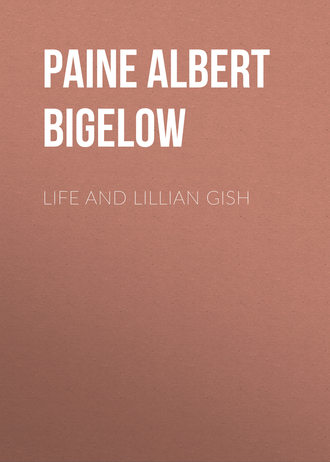 полная версия
полная версияLife and Lillian Gish
“In April, Mother, Miss Davies and I sailed for Hamburg. We arrived at Cuxhaven early one morning. Mother had to be carried to the train and to a private car. Reinhardt was already over there. His secretary met us, and Mr. Melnitz, head of the United Artists in Germany.
“At Hamburg, we put Mother to bed for two hours. She had been up since half-past four. Nurse and I had not slept all night. We took train for Berlin, arriving at six in the evening. I had not realized that Germany is like America in the matter of news. I supposed we would go in quietly. Instead, we found the station literally jammed with people, all trying to get around us. It was terribly hard on poor Mother.”
There were a dozen or two camera-men, and when they found they couldn’t all take pictures of Lillian, they got around Mrs. Gish, who was in a big chair carried with poles. She could not tell them that she did not want her picture taken, and began to cry. When at last they got into an automobile, all the camera-men and reporters jumped into other cars and came racing behind, taking pictures all the way to the hotel. During the next few days, Lillian was too nervous to give more than a few interviews. Reinhardt comforted her by saying that no artist ever had come into Germany with such a reception from the press.
At Berlin Lillian consulted Professor Vogt, head of the Kaiser Wilhelm Institute, supposed to know more than anyone else about cases like her mother’s. Professor Vogt said he could not do very much for Mrs. Gish, but warned Lillian that she herself was likely to be headed in the same direction. He advised that her mother be taken to Doctor Sinn’s Sanatorium at Neubabelsburg, advice promptly followed. Mrs. Gish remained there a year.
To Lillian, in Berlin, came this letter:
O smallest blonde:
You must not think of any other place but Leopoldskron! Max Reinhardt and we all would think that we had failed completely to please you. Besides, the hotels are now terribly over-crowded and you would be perfectly miserable there. So please, do overcome any inhibitions, and come to Leopoldskron! I am expecting your wire about train and hour.
We are just having Anthony Asquith and Elizabeth Bibesco here. This means that the whole castle is one flaming song in gloriam Lilliane Gish....
I do hope that Professor Vogt will entirely satisfy the expectations of your poor mother. My sincerest wishes and regards to her … Schloss Kommer and Salzburg are sending you loving greetings. Au revoir! Yours ever,
R. K. Kommer
“I went to Salzburg,” Lillian said, “to Leopoldskron. Reinhardt and his secretary, Miss Adler, were on the train, and Kommer was at the station to meet us. Leopoldskron is a huge place, a little way out of Salzburg, built hundreds of years ago. I don’t know how many rooms it has, but only candles were used to light them. I was much impressed when we drove up to it, and when we got inside. There were ever so many guests, distinguished persons from everywhere. It is like a great hotel, and has three dining-rooms. Among the guests, was the poet Hugo von Hofmannsthal, who had come to work on the story we had planned for our picture. Kommer got me a maid, Josephine, whom I afterwards brought to America.
“We worked three weeks on our story, that time; then I went to Paris for a fortnight, then to Mother at Neubabelsburg. Later I went to Leopoldskron for another three weeks, to meet Mr. Joe Schenck, who had come over to hear the story. Frances Marion was in Salzburg by that time. She said we had a wonderful theme. Schenck also liked it—said we should get back to Hollywood as quickly as possible, and make it. Possibly he suspected that something was likely to happen—something like an earthquake in the picture world. Off there in that corner of Austria, we never dreamed of it.
“I was anxious to see something of Austrian peasant life at close range. At Leopoldskron was the artist Feistauer. He himself was a peasant, and he asked me to pose for him. So we made a bargain. I agreed that if he and his wife would go with me, I would get a car, pay the expenses of the trip and he could take us to the part of the country he knew. If he would do this, I would pose for him. He was quite willing, and we arranged our party. There were five of us besides the chauffeur: Feistauer and his wife; von Hofmannsthal’s son Raymond; myself, and Josephine, my maid.
“It was a wonderful experience. I saw peasant life as I should never have seen it otherwise. We would stay a day and a night in a peasant house—huge houses they had, like those in the Schwartzwald, with their animals in one part of it. Their food was a coarse bread, milk and potatoes, placed on a kind of framework in the middle of the table. I was so impressed with it all—different from anything I had ever seen:—the great room below, the small chambers above. The combined living-room and kitchen was sometimes very beautiful. The great cooking-stoves so unlike any I had known. Beautiful, too, because primitive.
“We came one day to a house where a man walked out to meet us, carrying a child in his arms, leading another. I thought he had the most wonderful face I had ever seen, a perfect Christus. He was followed by some geese, two dogs and a baby lamb. He came up and greeted us with the word they use with strangers, ‘Christgott,’ and led us to the house. He apparently knew Feistauer, but his greeting to him was the same as to us. We sat down for a little; then he took Raymond and myself through the house. We were there perhaps an hour in all. When he had gone I said to Feistauer: ‘If you should ever wish to paint the Christus, I should think you would use that man. He is nearer my idea of the Christ than anyone I have ever seen.’ Feistauer said: ‘I have done so, often. He is my brother!’ Because Feistauer had given up the land to be a painter in town, he was, in a sense, an outcast, a stranger—no more than any other of our party.
“It was at the end of my second visit to Salzburg that I saw the miracle girl, Theresa Neumann—at Konnersreuth. I was on the way to see Mother again, and stopped off there. She was to be the subject of our picture, and it was very necessary that I see her. No one is allowed to do so without special permission. I had letters from the Archbishop of Regensburg. Josephine, my maid, went with me.
“I found poor, the very poorest, accommodations in the peasant village where Theresa Neumann lived. She is just a peasant girl herself, the eldest of eleven children, about thirty years old when I was there. Hundreds try to see her, but only members of the clergy, or those with special permits, can get near her on the days of the miracle. There is no charge of any sort, and her people are very poor, helped a little by the Church.
“It is the most amazing sight in the world. Her ecstasy begins about one o’clock Friday morning, and lasts until noon. The wounds, which are closed and black between times, open, and blood flows from them—from those on her hands and feet, from the spear-wound in her side, and the thorn-wounds on her forehead. Tears of blood drip from her eyes, run down her cheeks, and stain her white gown. I was within three feet of her, and saw all this. I don’t expect anyone to believe these things, but I saw them, exactly as I have said, and if it is trickery, it is beyond anything of the sort I have ever heard of. I asked her to pray for Mother, and I believe she did. Mother got better, so it may have helped.
“The miracle has been accounted for in many ways, both by skeptics and believers. The believer, a priest, who talked about it to me, called her a ‘child of grace,’ which may be as good an explanation as any, if one knew what it meant. Dozens of books have been written about her. Perhaps she is all mind, but that seems a poor explanation. It is claimed that she has not taken food or drink for a number of years. Incredible, of course, but no more so than the things I saw.”
XI
THE SHADOW SPEAKS
Lillian left her mother in the sanatorium, where apparently she was improving, and with Josephine, her maid,—booked as a “fellow artist” (she was really that, for she would serve as model for Austrian peasant girls in the picture),—Lillian sailed on the Île de France, for New York. Reinhardt presently followed, with the play itself, which von Hofmannsthal had completed. Young von Hofmannsthal came as Reinhardt’s assistant. These two, with Lillian, and Josephine the “fellow artist,” descended upon Hollywood.
Alas, for the beautiful, silent picture play of “The Miracle Girl of Konnersreuth.” They were just a year too late!
For now it was that the long-unexpected-inevitable had happened: All in a brief summer and autumn—in a night, really—a change had come over the flicker of the photographic dream … it SPOKE!
The film with a voice—a possibility for twenty years or more—hardly taken seriously except by the inventors—now, all at once, had arrived. Rather doubtfully at first—a crude thing, but of instant popularity. The writer of these pages remembers a fierce summer day in ’28, when he slipped into a jammed and darkened house on Broadway, and sat on the floor in a remote corner, fascinated, watching the moving phantoms, silent heretofore, as they shouted wildly at each other in the mise en scène of a haunted house. After that, when he heard friends say: “It is just a novelty—it will not last,” he was not convinced. If he knew anything at all, he knew better than that. If they could do so much, they would presently do more. They did. The Warners put out Al Jolson in “The Singing Fool,” and the doom of the silent film was not only written, but sounded very loud. The play itself was hardly a classic—it didn’t need to be. Jolson’s speaking and singing voice was up to microphone requirements—sound and vision were synchronized. The record was miles beyond anything attempted before. The “Talkie” had come!
A huge shudder ran through the ranks of movie actors. Many of them did not even speak English. Many of them did it very badly—provincially, nasally, flatly, indistinctly, or with an impossible accent. Of those who spoke it well enough, not all had voices suited to the microphone—(“Mike,” as they irreverently named it)—they recorded poorly. Their voices had to be “placed.” Voice culture became a new Hollywood industry. Some, even, began learning to sing.
It was just at this point, late in 1928, that Lillian and Reinhardt reached Hollywood. The press heralded their coming, recounted the story of Reinhardt’s life, and distinguished work; how now with a new and marvelous story, written by von Hofmannsthal in the great castle of Leopoldskron, for the “first lady of the screen,” he was ready to enter and electrify the picture world.
Good publicity, but it fell on deaf ears. Jolson HAD MADE the “Jazz Singer”! Chaos ruled in the studios. A dozen producers who didn’t know whether they stood on their heads or their heels, shouted that it was all just a passing fad, but meantime were knocking together “sound stages” and engaging people who could talk prettily to “Mike,” or sing, or do anything that would make a convincing noise.
Of course, everyone still believed in the old silent pictures, but nobody wanted to start one. Those already begun were dropped. Gloria Swanson, at great loss, stopped a half-completed film.
Reinhardt and Lillian were dazed. Joe Schenck, who in Salzburg had bid them hurry home to make their picture, now repudiated it—told them to make a talkie of it. Reinhardt protested, then went into the desert—not to fast and pray, but to do what Schenck demanded.
No use. He had been working for a year on a silent picture. Now to make the shadows speak … impossible. Even the desert … even fasting and prayer … even “The Miracle Girl,” could not accomplish it. He lingered through the winter, hoping that those who said the talkie was just a fad were right. Then....
Lillian sighed as she remembered these sorrowful things:
“Hollywood, always more or less mad, was really an asylum. Even Mary was doing a talkie, ‘Coquette’4; Chester Morris was doing another ‘Alibi.’ Nobody was doing our beautiful old silent pictures, any more. Everywhere you heard the hammering of workmen building sound stages. Then—with Spring—Reinhardt returned to his neglected theatres, to his castle at Salzburg. It had been a great loss to him. I was not responsible, for he had signed his contract with United Artists before I had, but I felt terrible over it. He never blamed me, or was anything but fine about it. I did not see him again until last Summer (1930), when I was in Paris. We spoke of the pity of it all—his coming at the wrong time, when it was too late—too late and too early. Another year, and he might have been in the mood for a talkie. He had really come on a sincere errand. Most of those who come, come just for the money in it. He had come for a finer purpose.”
XII
ON THE FLYING CARPET
Lillian looked out of the window of the den, on the boats passing up and down, perhaps reflecting a little on the uncertainty of human undertakings.
“I have one bright memory of that gloomy Spring,” she said presently. “One morning in March, while Reinhardt was in the desert, Douglas Fairbanks called me up, and asked:
“‘Are you game to do something?’
“‘What is it?’ I said.
“‘Never mind; are you game to do it?’
“‘Are you and Mary going to do it?’
“‘We are.’
“‘Well, then I will.’
“‘All right. We’re going on a plane to have a look at the war in Mexico. Will you go?’
“‘I should think so. When do we start?’
“‘Right away, as soon as we can get ready.’
“I went up to Pickfair, to see Mary as to what we were to take. We met at the studio about eleven o’clock, drove to the Glendale Flying Field, and got into what seemed a very big, powerful plane. There were ten of us altogether: Doug and Mary; Doug’s brother, Robert, and his wife, Lurie; Mary’s niece (‘Little Mary’); two cousins, Verna and Sonny; myself, and the pilot and captain. There was plenty of room and we got off without any trouble.
“But it turned out that our motors were not powerful enough. We meant to cross the mountains by the San Bernardino Pass, but when we were over the low first range, we ran into a storm of wind and snow, and our engines would not lift the plane over the Pass. The snow got so thick that we could not see a thing in any direction—just a white, whirling mass. We were likely to run into the mountain-side, any moment. We rolled and billowed around, three times turning back, and trying it again. Then the captain, very white, came and shouted into Doug’s ear that it was madness to go on, that we had better turn back and follow down the Coast to Mexico. It was impossible, the captain said, to find the Pass.
“We turned back, and all were relieved. There had been no question as to the danger. Less than a year later, a big plane with a party was lost up there, dashed against the mountain-side.
“The weather was better as soon as we got away from the mountains, and along the Coast was fine. At Agua Caliente, Mexico, we ate dinner and spent the night.
“We telephoned for a larger plane, and a big Wasp came down. All got into it except Robert Fairbanks, who said he knew when he had had enough, and that the day before had satisfied him. We left about eleven o’clock. For some reason, we did not take much along in the way of food, and about three P. M. our crowd began to look rather poorly—hungry and seasick. Even Douglas shushed Mary when she started to tell her troubles. He had a greenish look, and not at all his usual high-hearted manner.
“We got to Phoenix, Arizona, about five, starved, and went to the beautiful hotel. They lodged us all in one bungalow, and immediately we called loudly for tea and sandwiches. We spent the night there, left around nine, next morning. We flew to Grand Canyon—not really to the Canyon, but to the nearest flying field, and drove to the Canyon by motor. There we took a long walk along the rim, and looked down on the Canyon in the evening light, one of the strangest and loveliest and most impressive sights in the world—really sublime.
“Next morning, we motored back to the plane and headed Westward. We got hungry, but there seemed no good place to stop for luncheon. All we could see were poor little Mexican or Indian villages, in the desert. Finally, we got to Las Vegas, and after luncheon flew homeward, over the mountains we had been unable to cross when we started, dropping down into the San Fernando Valley at sunset, as on a magical flying carpet. We had had four beautiful days. We did not see much of the war, though at one place in Mexico we saw smoke, and thought we heard the sound of distant firing. Douglas had believed it unwise to go any nearer. We might be taken for spies, and pursued—even brought down. After all, war was not what we really cared to see.”
XIII
“ONE ROMANTIC NIGHT”
It is difficult to realize the size of the catastrophe resulting from the sudden production of talking pictures, even of pictures with “sound effects,” as many of them were, at first. Some of them really talked—better, or worse, than others. No matter; every picture theatre in New York, and most of them on the road, were presently being “wired for sound.” All the millions (possibly billions) of dollars’ worth of silent pictures, shrunk in value at a ghastly rate. The Eastern Hemisphere, the only market for them presently, was comparatively unimportant. Hundreds of pictures were useless; picture players found themselves “out of a job.” Stars began to pale and disappear.
On the other hand, ill as was the wind, it dispensed benefits. Stage players out of employment found market for their trained speech. Their feet warmed the way to Hollywood. A good many were already there. As the months passed, the screen showed more of the old familiar faces. Broadway to the rescue. Even the great succumbed. George Arliss, master of diction, joined the procession, Ruth Chatterton—eventually, Lillian.
Not willingly. She still believed in the silent film. She had objected even to the lip movement, the simulated speech insisted upon by the directors. To her, the perfect picture must be pure pantomime—with music—appropriate music, as in “Broken Blossoms.” It would never be that, now. Beautiful Evelyn Hope was dead. There is no help for such things. Tears, idle tears. Since the beginning of time, grief has never repaired a single loss. One might as profitably wail over the sunken Atlantis.
She still had her contract with the United Artists, and by its terms must make at least one picture before she could cancel it. She had hoped to get out of it altogether; but while it did not mention talking pictures, she was advised to abide by the terms.
“It would involve me in a suit with the United Artists, and I had had suits enough. As it was, I barely avoided another: The company had agreed to let me do Eugene O’Neill’s ‘Strange Interlude,’ if I could get it for a reasonable sum—I could have it to take the place of the Reinhardt picture. I came East in April (1929), to see Mr. Madden, O’Neill’s agent. I could have it for $75,000. This suited Mr. Joe Schenck. It suited Mr. O’Neill. We had the papers drawn up. I was to sign them that morning, and it was only because I was protected by an angel that I didn’t do it. On that very day, a woman brought suit against O’Neill, for plagiarism. Had I signed that contract, I should have been involved in the suit. She was beaten, and had to pay costs, but the damage to O’Neill was more than that, in fees.
“Meantime, Dorothy had gone to Germany and brought Mother to London. Mother was tired of sanatoriums and hotels. She wanted a home, and I decided to have one. I joined them, and Dorothy and I went to Paris, to collect furniture for an apartment. I had most of it made, copies of old French pieces.
“I came home in August, and all through that month looked for a place to live. It was a terrible search in the heat. When I saw this apartment, with its outlook on the river, its quiet air and sunshine, I knew that it was what we wanted.
“My friend, Mr. Paul Chalfin, kindly looked after the decoration, and I started at once for California, to do the picture we had selected, ‘The Swan.’ This was during the latter part of September, 1929. The apartment would not be ready before November.”
In California, Lillian lived with Madame de Grésac, at Beverly Hills. There was just then a good deal of talk about kidnapping, and she was advised against living alone. Josephine, her Austrian maid, had remained in Los Angeles, but met her at the station, with flowers and tears.
Careful preparation for “The Swan” began. Lillian was admirably suited to the rôle, that of the fair Princess Alexandra, her voice quality and diction needed only slight adjustment. Melville Baker had written the script for “The Swan,” adapting it from his translation of the original play by Ferenc Molnar. She thought very well of it, and hoped for the best.
She wrote Reinhardt of her decision, and received a gracious reply. Both artistically and from the business point of view, it (“The Swan”) ought to be a success, he said, and added:
In spite of all those rather disagreeable experiences I had to go through in Hollywood, I have kept the time I spent there in most agreeable remembrance. To have been together with you, your undeviable artistic spirit, blossoming there like a rare lonely flower, and the pureness of your conviction, made me happy and will remain for me an unlosable experience for all time to come....
Making a picture now was a different matter from those very recent old days. Then, a set where action was in progress, was about the noisiest place on the lot. Stagehands and various bosses shouting to one another, the director shouting at the players—noise, noise, no end to it. Now, all was silence. Every sound, even the feeblest rustling, was recorded by the microphone. Except for the actors, their laughter, their breathing, the accessory beat of rain, or hail, the stillness was perfect. The sound stage was a padded cell.

“THE FIRST LADY OF THE SCREEN”
“With the preparation and all,” Lillian said, “I worked about three months on ‘One Romantic Night,’ as they called the picture later. Mary Pickford has a bungalow on the lot, and lent it to me. I used it as a dressing-room, sometimes I slept there, when I had to be on the lot very early. I had Georgie, my dog, and Josephine. It would have been well enough, but they were building soundstages all about, which made a great deal of noise, all night long. It was a complete little house. Josephine cooked for me when we stayed there.
“I arrived in New York Christmas morning, with a wild turkey, which I got in Arizona. It had been brought to the train by some friends of a little girl who had done my hair out there. They had often sent turkeys to me, to California. It was all dressed, and all the way across the continent, cooks on the diners kept it in their refrigerators. They were very much interested.
“We had dinner in our new apartment, our first real home. Mother was delighted with it, and has seemed better and more contented ever since. Her pleasure in it makes us all so happy.”
“One Romantic Night” was a photographically beautiful picture, with a distinguished cast. Lillian, as Princess Alexandra; Rod La Roque, as the Prince (sent, against his will, to woo her); Marie Dressler, as her designing mother; Conrad Nagel, as a tutor, in love with Alexandra; O. P. Heggie—altogether a fine company.
Yet it has been called a poor picture, and Lillian today is not proud of her part in it. It was by no means a failure. Never had she looked more lovely. No longer a victim of tyranny, brutality and betrayal, but a Princess, as rare as any out of a fairy tale, with a palace and a rose garden and suitors, with a lilting, perfectly-timed voice, Lillian appeared to have come into her own. Her acting and beauty furnished no surprise, but her voice and laugh did; she had been silent, and sad, so many years. The audience followed her through a presentation, in itself seldom more than mildly exciting, and not always that. The tutor’s astronomy at times wearied, not only the Prince, but, unhappily, the audience. Marie Dressler’s broad comedy was highly amusing, but there were moments when one got the impression that the play was not only very light comedy, as apparently it was meant to be, but a good farce gone wrong.









